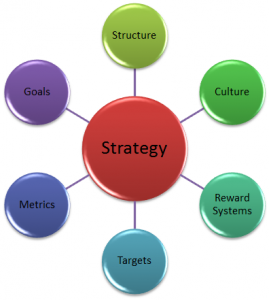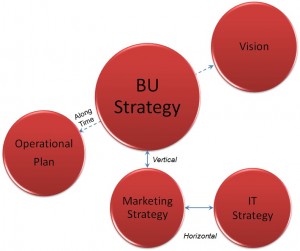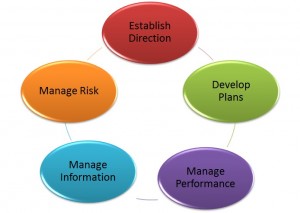A framework structures our thinking, making it less likely that we ignore some element and increasing the chances that we do consider all relevant relationships between the elements. The idea is to choose a suitable framework as a starting point and make adjustments to it as part of the learning process.
Strategic alignment can be seen as both state and process.
…As State
As a state, the term strategic alignment refers to the levels of alignment in different areas or between organisational elements. It is useful to think about overall alignment as the aggregate of the alignment between pairs of elements (e.g. strategy and process, process and structure). The set of organisational elements that can be aligned could be very large (e.g. strategy, structure, processes, reward systems, objectives). The number of separate relationships between pairs of elements can be much larger. So it is important at any point in time to restrict consideration to a few elements.
Inter-component alignment refers to the relationship between different elements (e.g. strategy and structure).
Intra-component alignment refers to the level of alignment between different instances of the same element. For instance, one can consider alignment between strategy at different organisational levels (e.g. marketing strategy with overall business strategy), different parts of the organisation at the same level (IT and marketing strategy) or different points in time (short- with long-term). There are thus three forms of intra-component alignment: vertical, horizontal and along the time axis.
The challenge involved in building a model based on quantitative measurement and aggregation of alignment should by now be obvious. A reading of the Concepts page on this website would make it clear that this is not necessarily the appropriate approach.
…As Process
The term alignment (or ‘aligning’) is also used to refer to the process of improving alignment. One way to improve alignment is to make changes to organisational processes. One framework for alignment as a process consists of five business processes generally associated with the term Business Performance Management (BPM):
- Establish Direction: Results in the articulation of Mission and Vision statements, stakeholder destination statements and definitions of Core Values.
- Develop Plans: Results in Strategic Plans, Financial Forecasts, Operational Plans and Budgets.
- Manage Performance: Results in people and operational processes performing optimally.
- Manage Information: Results in the right financial, management and operational information being available to those who need it.
- Manage Risk: Results in an enterprise risk profile matched to the organisations appetite for risk.
You could choose from a number of frameworks, but the one described here has been validated in theory and practice under a variety of conditions.


